Most of us have seen lizards very well. The unique design and appearance make the actual difference in them. Body coloration and design are the things that enhance the look of the species in every way. Not only lizards, birds, and other animals possess blue color.
However, the blue color is not common due to see due to its low pigmentation presence in the world. Have you ever seen a lizard bearing a blue color?
If not, you will get to see many blue lizards in this article. The striking and vibrant hue you see can be a result of lighting seeing from a particular angle.
The beautiful imagination these unique species slither is present in various corners of the world. The diverse habitat can be crazy as you never know what unique animal you might encounter. Moreover, the blue color sets the species apart from any of the given.
However, it is not the case every time. It leaves people in awe as their graceful looks mesmerize many of them.
The main point of this article is to introduce our readers to a variety of blue lizards found on this earth. You will see the variation in their body colors and design that will mesmerize and excite you. So, without further ado, let’s get into this article.
How Common Are Blue Lizards in The World?
Blue-colored reptiles are not common to see. Usually, the color variation can be a result of genetic mutation that gives a unique body color to the species. Blue is not common body coloration that you can see in amphibians and reptiles.
The reason behind this is still unknown. Blue is the least common color in reptiles as the pigment that causes blue color doesn’t found in any reptiles or amphibians.
You might see a variety of land animals showing unique body coloration but seeing a blue-colored reptile is unique in every way. Most of the time, the body coloration showing blue color can be a result of light or any other thing.
Although, you can encounter several blue lizards in different areas of the world that show a beautiful body design and body color that adds a jewel to their look.
16 Extraordinary Blue Lizards
There are a variety of blue species found on this earth. You can see the fascinating presence of these species in the diverse reptilian world.
The vivid body color sets these lizards apart from any other present in this world. Blue lizards are uncommon to see. Here is the list of extraordinary blue lizards in the world:
1) Blue-Spotted Tree Monitor
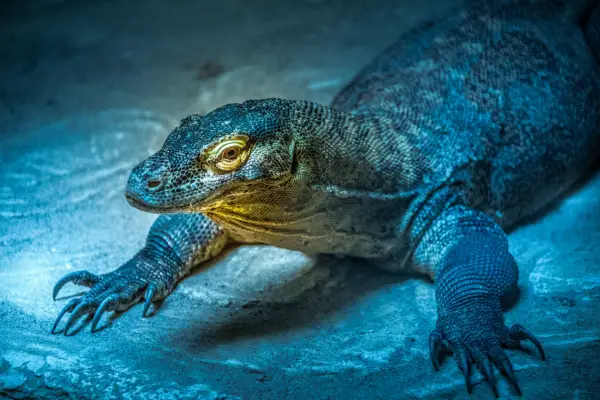
| Scientific Name | Varanus Macraei |
| Size | 36-43.2 inches |
| Habitat | Tropical Forests |
| Location | Islands of Batanta |
| Diet | Carnivores |
A stunning reptile is known for the vibrant physical appearance it shows along with its characteristics.
Blue-spotted tree lizard is an arboreal lizard that shows a vibrant blue color and irregular pattern on its body. They are well known for their intelligence level and calm mind.
2) Electric Blue Gecko
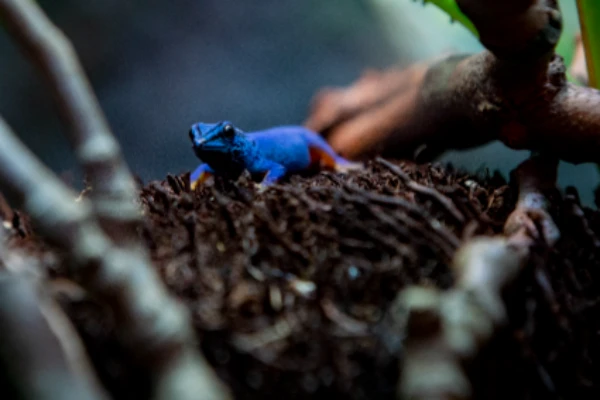
| Scientific Name | Lygodactylus Williamsi |
| Size | Up to 3 inches |
| Habitat | Forest in Tanzania |
| Location | Eastern Tanzania |
| Diet | Insectivorous and Frugivorous |
A small reptile is known for its stunning appearance and versatile characteristics. This species of blue lizard shows a vibrant, electric blue body coloration.
This species possesses a fragile limba with a long tail that makes its movement faster. One of the most things about them is they change their body color according to their mood and temperature.
3) Rainbow Whiptail
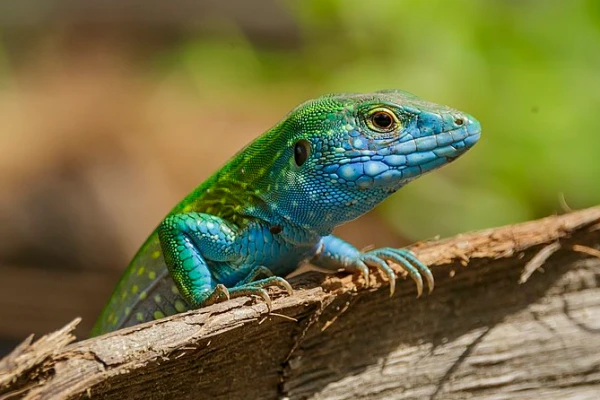
| Scientific Name | Cnemidophorus Lemniscatus |
| Size | Up to 12 inches |
| Habitat | Sandy Beaches or Forest Edges |
| Location | Central America, The Caribbean, and Northern South America |
| Diet | Insectivorous |
As the name says rainbow whiptail, this species of lizard shows a variety of unique colors. This species of lizard is commendable in every way.
From different hues, a strong hue gives them a unique look. Also, these species have a series of bold and irregular patches all over their body.
4) Grand Cayman blue iguana
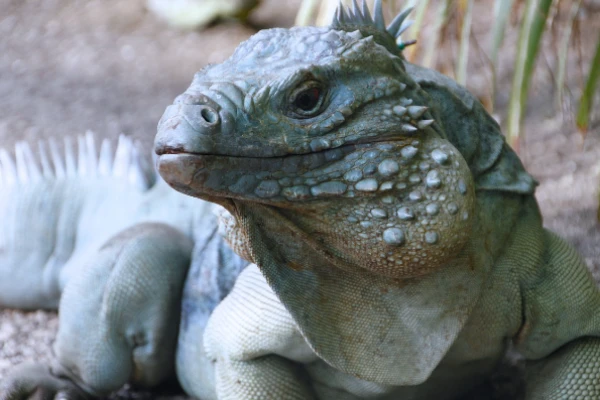
| Scientific Name | Cyclura Lewisi |
| Size | Up to 60 inches |
| Habitat | Dry, Rocky Forest in coastal area |
| Location | Grand Cayman Island |
| Diet | Herbivorous and Frugivorous |
Grand Cayman blue iguana is a unique endangered species that shows a striking physical appearance with a distinct style.
The body of this species shows an elongated rough body with bumpy scales. Also, they possess a vibrant turquoise-blue color. The muscular body of this species gives them busty look.
5) Little Striped Whiptail
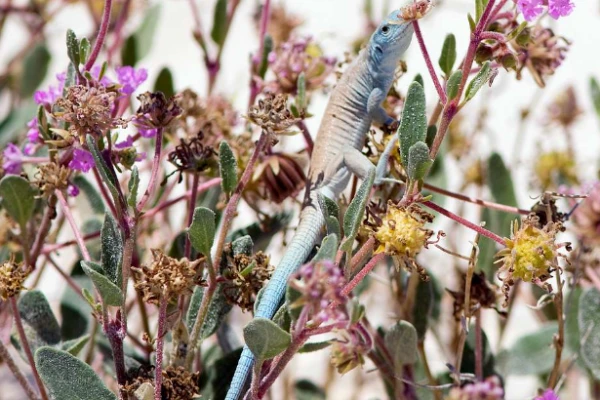
| Scientific Name | Cnemidophorus Inornatus |
| Size | 6.5-9.5 inches |
| Habitat | Grasslands to semi and rocky slopes |
| Location | Southwestern United States and Northern Mexico |
| Diet | Insectivorous |
Little striped whiptail is another species of lizards that are famous for their long striped tail. This species has a variety of patches and stripes running over its body and are mostly active during the daytime.
The unique shades of different color gives this species a unique look throughout their lives. Also, the design is something that makes them recognisable.
6) Siamese Blue Crested Lizard

| Scientific Name | Calotes Mystaceus |
| Size | Up to 5.5 inches |
| Habitat | Terrestrial and Arboreal |
| Location | Southeast Asia |
| Diet | Insectivorous |
One of the most beautiful lizards anyone can ever see. Siamese blue crested lizards are known for their distinctive physical appearance with unique characteristics.
This species also has a crest on their head makes them unique. The dazzling blue coloration makes them unique and beautiful at the same time.
The eye-catching appearance of this species makes them unique in every way. The arboreal lifestyle of this lizard helps it in escaping predators’ attacks.
7) Kenyan Rock Agama
| Scientific Name | Agama Lionotus |
| Size | 5.1- 11.8 inches |
| Habitat | Dry and arid area |
| Location | Tanzania, Uganda, Kenya, and Ethiopia |
| Diet | Omnivorous |
Kenyan rock agama is another distinctive species of lizard that are known to have a vivid combination of blue, red, and orange.
This species shows a beautiful hue on its body that makes them unique and significant. This species possesses well-developed limbs and claws that allow them to sustain itself in rocky lands.
8) Southern tree agama
| Scientific Name | Acanthocercus Atricollis |
| Size | 4.7-5.9 inches |
| Habitat | Woodland and forest clearing habitat |
| Location | KwaZulu Natal |
| Diet | Carnivorous |
Southern tree agama is a vivid species that show a variety of body coloration. The species shows a wide range of patterns accommodating their body.
However, the males can change their body color and display a wide range of hues of bright to dark blue all over their bodies.
9) Eastern Collared Lizard
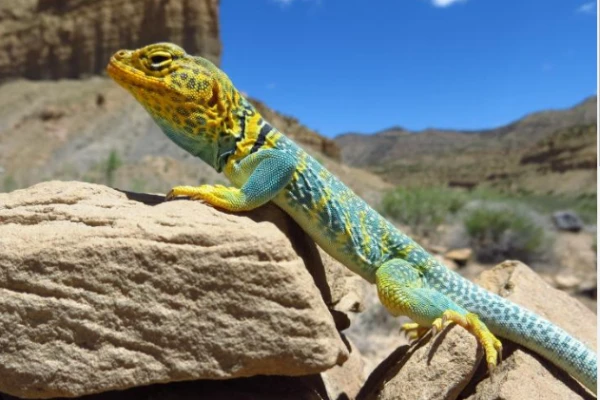
| Scientific Name | Crotaphytus Collaris |
| Size | Up to 10 inches |
| Habitat | Rocky areas with sparse vegetation |
| Location | Northwestern Arizona |
| Diet | Carnivrous |
A medium-sized lizard that possesses a muscular body having quick movements. Here is Eastern Collared lizard.
This species shows a wide range of color pattern that includes beautiful hues of blue, green, and gray color shades. The feature that allows them to be recognizable is the presence of black bands around their neck.
10) Western Skink

| Scientific Name | Plestiodon Skiltonianus |
| Size | 2-3 inches |
| Habitat | Dry Open forests, Shrub steppe, and Grasslands |
| Location | South Central British Columbia |
| Diet | Insectivorou |
Western skinks are captivating creatures well known for their small size. This mini species of lizard exhibit a remarkable diversity in its body coloration with patterns.
Although, you can see the unique hue of blue shade in their body and find them to be one of the most beautiful species alive in reptiles.
11) Aruba Whiptail
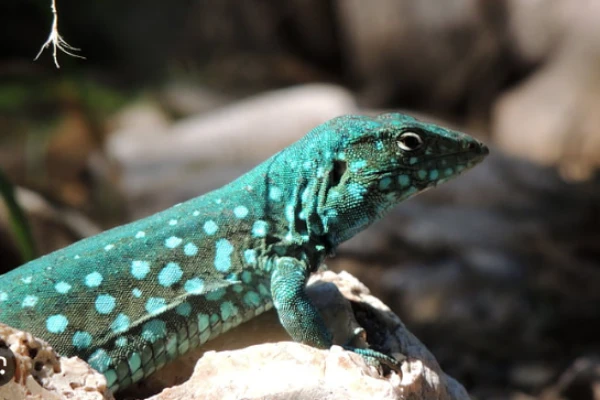
| Scientific Name | Cnemidophorus Arubensis |
| Size | 2-5 inches |
| Habitat | Islands of Aruba |
| Location | Aruba |
| Diet | Frugivorous |
Aruba Whiptail is a small species of lizard that has a slender body with a whip tail. The body displays a wide range of colors with dark stripes all over the body.
One of the most distinctive features of this species is it consists of only females that reproduce via parthenogenesis. You will be surprised to see them in real.
12) Grand Cayman Anoles
| Scientific Name | Anolis Conspersus |
| Size | Up to 58.8 inches |
| Habitat | Low tree trunks and forest floor |
| Location | Cayman Island |
| Diet | Herbivorous |
Grand Cayman is a small reptile that shows a wide range of distinctive features. From body length to color, it gives the beautiful look of the species.
The dewlap flap is present beneath the throat which makes them unique among other species. Their distinctive features of them give this species uniqueness in every way.
13) Southern Crevice Spiny Lizard
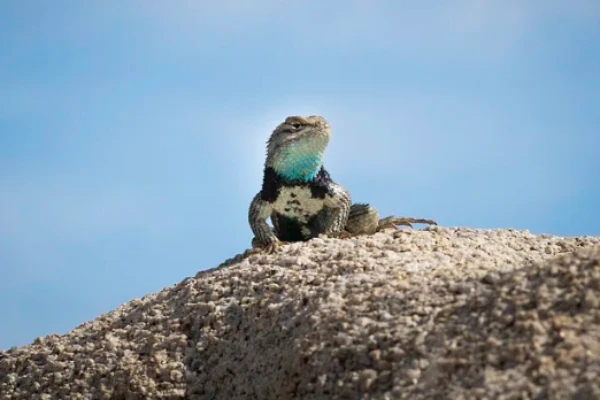
| Scientific Name | Sceloporus Poinsettii |
| Size | Up to 4.6 inches |
| Habitat | Rocky terrains and semi-arid area |
| Location | Southern New Mexico, Central Texas, and Northern Mexico |
| Diet | Omnivorous |
A species of lizard that is native to the southwestern united states exhibits a distinctive physical appearance with notable characteristics. This species is comparatively smaller with a slender body.
Also, you will see dorsal scales on their body giving them a prickly appearance. The scales covering their body show a wide range of colors that helps this lizard in showing camouflage in the rocky lands. They also possess the capability of changing color as per their body temperature.
14) Uganda blue-headed tree agama

| Scientific Name | Acanthocercus Ugandaensis |
| Size | Up to 15 inches |
| Habitat | Forests, Savannah, to built up areas |
| Location | Uganda and Tanzania |
| Diet | Insectivorous |
A visually striking reptile that shows vibrant body coloration on its body. This is the symbol of beauty in reptiles that is liked by many.
Uganda Blue-headed tree agama is another species of lizard that shows a wide range of body colors on their body.
The arboreal lizard shows distinct physical characteristics that justify its habitat. With a distinctive blue head, you can easily recognize this species. Also, the vibrant body color attracts females during the breeding season.
15) East Arabian Desert Agama
| Scientific Name | Pseudotrapelus Jensvindumi |
| Size | 7 inches |
| Habitat | Low land desert, particularly sandy areas |
| Location | Northeastern Africa and Middle East |
| Diet | Insectivorous |
East Arabian desert agama is a unique species of lizard that shows a blue head and are found in arid regions. Mostly this species is found in the Arabian peninsula that exhibits different color patterns.
The vibrant color makes this species one of the most beautiful yet adorable. The most interesting feature of this species is its vibrant body coloration. The dark body color shows they are threatened or undergoing camouflage.
16) Vivid Rainbow Blue Lizards
| Scientific Name | Cnemidophorus Spendidus |
| Size | NA |
| Habitat | Tropical lowland oak |
| Location | Venezuela |
| Diet | NA |
Like the name says rainbow, this species of lizard shows a wide range of colors in its body. The rainbow coloration makes this species unique to look. This uniqueness makes them one of the most beautiful species found on earth.
This captivating creature mesmerizes your mind. Also, the presence of shimmers on its body gives a true marvel look. The hue you see on their bodies is enough to recognize them. Also, the vivid combination of different colors serves their purpose in visual adaptation.
Conclusion
The species are immensely perfect in every way. Their beauty and their habitat tell a lot about them. You can easily encounter a wide range of species. You can always discover any kind of species among lizards.
However, the main point on which the judgment can be done is the habitat and the diet along with their personality. This world consists of many more species to be found.
In this article, we have specifically targeted blue lizards found in the world. You get to understand their lifestyle and what they look like.
Now we have discovered many species showcasing different hues of blue color on their body making them beautiful and unique. We hope that you will like this article. We will be back with another article soon. Till then, stay tuned with us.
Also Read:

An engineering student turned into a writer. Expressing thoughts into words is what i prize the most. Being able to conclude my thoughts through my articles is my prime intention. If i am not engaging myself with animal content, you can always find me doing coding. I am an engineer by profession but a writer by heart.

